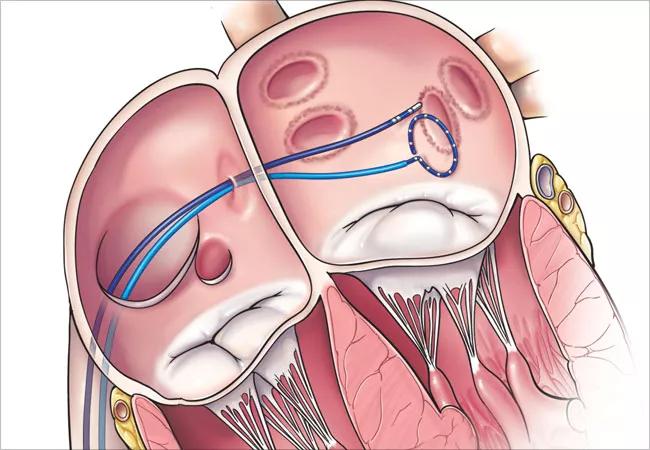Pushing the envelope in ablation of atrial fibrillation, ventricular tachycardia

A lattice-tip catheter combining the best of pulsed-field ablation and radiofrequency ablation. A new method for mapping and ablation in patients with scar-related ventricular tachycardia. And a strategy of high-power, short-duration ablation to improve the durability of pulmonary vein isolation in atrial fibrillation (AF).
Cleveland Clinic is a non-profit academic medical center. Advertising on our site helps support our mission. We do not endorse non-Cleveland Clinic products or services. Policy
Those were among the advances in catheter ablation technology and practice reported virtually by Cleveland Clinic electrophysiologist Elad Anter, MD, and colleagues during the recent Annual Scientific Sessions of the Heart Rhythm Society (HRS). This article recaps the essentials of those three advances and links to full detailed reports on the respective studies on each.
A novel lattice-tip focal ablation catheter (Affera Inc.) shows promise for combining the best aspects of pulsed-field ablation (PFA) and radiofrequency ablation (RFA) for treatment of atrial fibrillation, according to a first-in-human study. In addition to being presented as a late-breaking clinical trial during the virtual HRS sessions, the investigation was simultaneously published in Circulation: Arrhythmia and Electrophysiology.
“This technology combines PFA and RFA into a single platform, capitalizing on the improved safety of PFA — which has only a minimal effect on the phrenic nerve and esophagus — and the many years of experience with RFA,” says Dr. Anter, Associate Section Head of Cardiac Electrophysiology at Cleveland Clinic and Director of the Mark Josephson and Andy Wit Translational Electrophysiology Research Laboratory.
Dr. Anter, who was involved in development of the technology and is a coinvestigator in the study, adds that it allows AF ablation to be performed in unprecedentedly short procedural durations and with increased lesion flexibility for patient-specific tailoring.
The novel lattice catheter is a 7.5-French bidirectional catheter with a compressible 9-mm nitinol tip that can toggle between delivery of RFA or PFA lesions, each lasting 2 to 5 seconds, allowing rapid and flexible energy delivery. Operators can use PFA in the posterior wall, which is close to the esophagus, or throughout the ablation. They may choose to use RFA in thicker tissues or in ablation of arrhythmias where RFA has a longer track record. “The important novelty of this technology is the flexibility to perform focal ablation in a point-by-point fashion with the freedom to choose PFA or RFA, in contrast to other emerging technologies designed for PFA over multielectrode catheters for single-shot pulmonary vein isolation (PVI),” Dr. Anter says.
The prospective, international, single-arm investigation was designed to evaluate the safety and short-term efficacy of this technology in 76 patients with paroxysmal or persistent AF who underwent PVI and additional linear ablation using one of two strategies: either PFA posteriorly and RFA anteriorly, or PFA throughout.
PVI was successfully achieved in all patients, with a mean duration time of 22.6 ± 8.3 minutes. Linear lesions included 14 mitral, 34 left atrial roof and 44 cavo-tricuspid isthmus lines, all of which were acutely successful and achieved in relatively short duration. There were no major complications, including stroke, atrio-esophageal fistula, cardiac tamponade or phrenic nerve paralysis.
“This first-in-human trial demonstrated the safety and efficacy of this technology for treating patients with AF and potentially other arrhythmias,” says Dr. Anter. The next step, he adds, is to perform an FDA study in a larger group of patients and for additional arrhythmias. Read a more detailed study report here.
A new method for mapping and ablation in patients with scar-related ventricular tachycardia (VT) may improve the clinical outcomes of VT ablation procedures, reported investigators with the international multicenter Physio-VT study. Results were simultaneously published in Circulation: Arrhythmia and Electrophysiology.
The core of this new methodology is mapping of the heart during activation from multiple directions, in contrast to the standard technique of mapping from only a single direction. “The additional information obtained from mapping the heart during activation from multiple directions (and potentially cycle lengths) increases the sensitivity and specificity of mapping, which can be used for identifying the underlying arrhythmogenic substrate,” says Dr. Anter, the study’s principal investigator.
The clinical outcome of ablation in patients with scar-related VT has traditionally been disappointing, with recurrence rates of 30% to 40% within two years. “The major limitation of ablation is the insufficient mapping specificity for identifying and targeting the true arrhythmogenic substrate responsible for VT,” Dr. Anter explains.
The Physio-VT study was based on preclinical studies performed in Dr. Anter’s research lab and the lab of Dr. Andrew Wit, an emeritus professor of pharmacology at Columbia University and a co-investigator in Physio-VT. They found that VT circuits in healed infarctions often colocalize to sites exhibiting activation slowing during sinus rhythm. However, to identify the full extent of the circuit and all potential circuits, left ventricular activation from multiple directions is often required.
Physio-VT is a prospective, single-arm study of 85 patients with infarct-related VT refractory to antiarrhythmic medications. Mapping of the left ventricle was performed using high-resolution technologies and activation from multiple directions, including sinus rhythm, right ventricular and left ventricular pacing at a constant cycle length of 600 milliseconds. For each activation wavefront, the area of maximal activation slowing was marked and targeted for ablation.
In comparison to standard left ventricular mapping during activation from a single direction, left ventricular activation from multiple directions identified an additional ~30% of areas exhibiting slow activations that were responsible for an additional 25% of VT circuits that could not be identified during activation from a single direction. Over median follow-up of 3.6 years, only 16.5% of patients had VT recurrence, a significantly lower incidence relative to results from the published literature.
“The important physiological observations made by this pivotal study, as well as the remarkable clinical outcomes, are highly encouraging and may represent a paradigm shift in treatment of VT,” notes Dr. Anter’s colleague, Oussama Wazni, MD, Section Head of Cardiac Electrophysiology at Cleveland Clinic. The next step, Dr. Anter says, is a randomized controlled study led by Cleveland Clinic to validate these findings. Read a more detailed study report here.
A strategy of high-power (50 W), short-duration (8-15 sec) radiofrequency ablation during pulmonary vein isolation (PVI) results in improved long-term PVI durability compared with conventional moderate-power (30-40 W), moderate-duration (20-30 sec) ablation in patients with atrial fibrillation (AF). The high-power, short-duration (HP-SD) approach also shortens total ablation time. So concluded a prospective study presented at the virtual HRS sessions and simultaneously published in JACC: Clinical Electrophysiology.
“The incidence of AF recurrence after ablation is substantial, largely because of a high rate of electrical reconnection between the pulmonary vein and the left atrium,” says Dr. Anter, the study’s principal investigator.
To improve clinical outcomes with AF ablation and address the challenge of pulmonary vein (PV) reconnection, Dr. Anter’s translational research team has studied the biophysics of radiofrequency ablation using advanced computer simulations, ex vivo bench models and preclinical in vivo studies. They found that ablation at higher powers for shorter durations increases the desired effect on target tissue in immediate proximity to the catheter while reducing the undesired effect of ablation on neighboring structures, such as the esophagus and phrenic nerves.
In the current study, 112 patients with symptomatic paroxysmal or persistent AF were enrolled to undergo AF ablation using the HP-SD strategy — i.e., at a power of 50 W for 8 sec in the posterior wall and 15 sec in the ridge of the left PV and the septal aspect of the right PV. Results were compared with those of the preceding 112 patients who underwent ablation using a moderate-power, moderate-duration (MP-MD) strategy (20 W in the posterior wall and 35-40 W in the in the ridge of the left PV and the septal aspect of the right PV applied for 20 to 30 sec using a similar catheter technology). Acute PV reconnection was evaluated in all patients and chronic PV reconnection was examined in patients who required redo procedures.
Key findings included the following:
“Applying higher powers for shorter durations appears effective for PVI, as it reduced the incidence of PV reconnections and the overall procedural duration,” says Dr. Anter. “However, these data cannot be oversimplified. High power should be used diligently with careful attention to changes in impedance, temperature and electrograms. In particular, this strategy is effective for PVI and thin walls but not for thicker myocardium, which requires ablation at lower powers applied for longer durations to achieve transmurality without overheating the subendocardium.”
A key finding of the study, he adds, is the importance of catheter stability for lesion durability. “The accuracy of catheter stability required for creating durable ablation lesions is so high (< 1 motion) and is difficult to achieve when ablation is performed over relatively longer durations,” he says. “The advantage of the HP-SD ablation strategy is that this stringent stability is required only for a short time.”
Catheter and generator technologies are now being refined to allow HP-SD ablation in an even safer and more effective fashion. This involves new catheter designs with larger surface areas, multiple temperature sensors and high-energy generators. Dr. Anter’s research team has been involved in the development of these technologies and their evaluation in humans. Read a more detailed study report here.

Further acute testing not needed if ECG and high-sensitivity troponin are negative

Scott Cameron, MD, PhD, also brings wide-ranging research interests to bear

Pioneering U.K. vascular surgeon joins Cleveland Clinic

AHA statement is first comprehensive document on perioperative stroke reduction

Recognition reflects prioritization of long-term patient outcomes

Recommendations help distinguish exercise-induced remodeling from pathology

JACC review highlights factors unique to women, ways to tailor management

Study is the specialty’s first to quantify lack of women authors, committee members